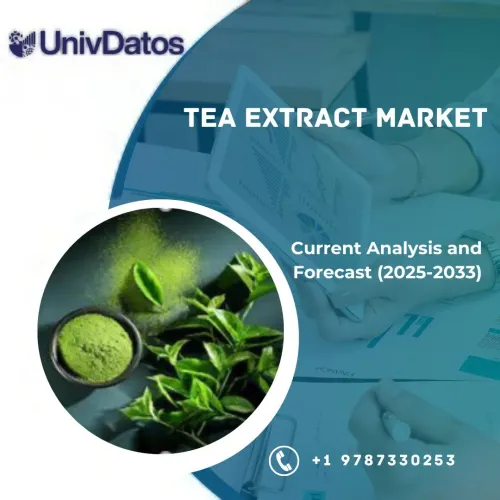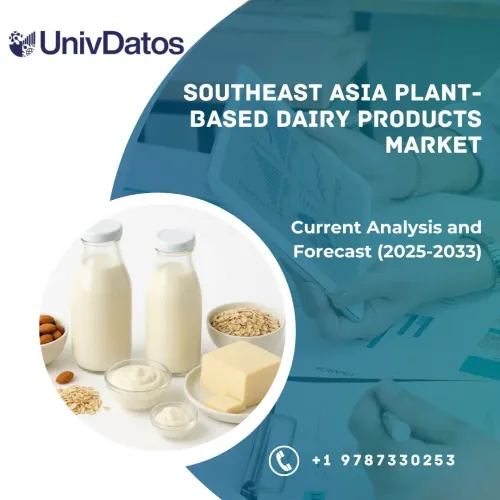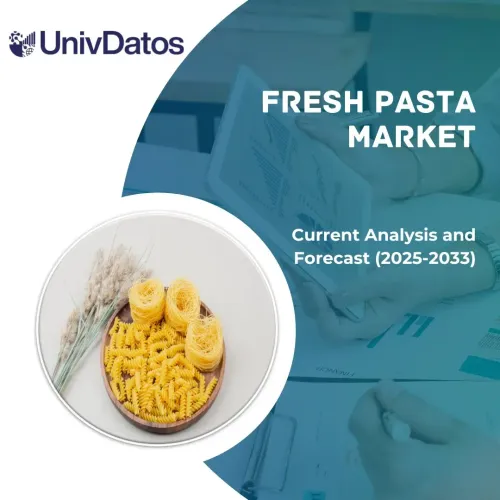- Home
- About Us
- Industry
- Services
- Reading
- Contact Us
MENA Tahini Market: Current Analysis and Forecast (2023-2030)
Emphasis on Packaging Type (Bottles, Tubs, Sachets, Jars, and Others); Product Type (Paste, Halva and other sweets, and Others); and Country
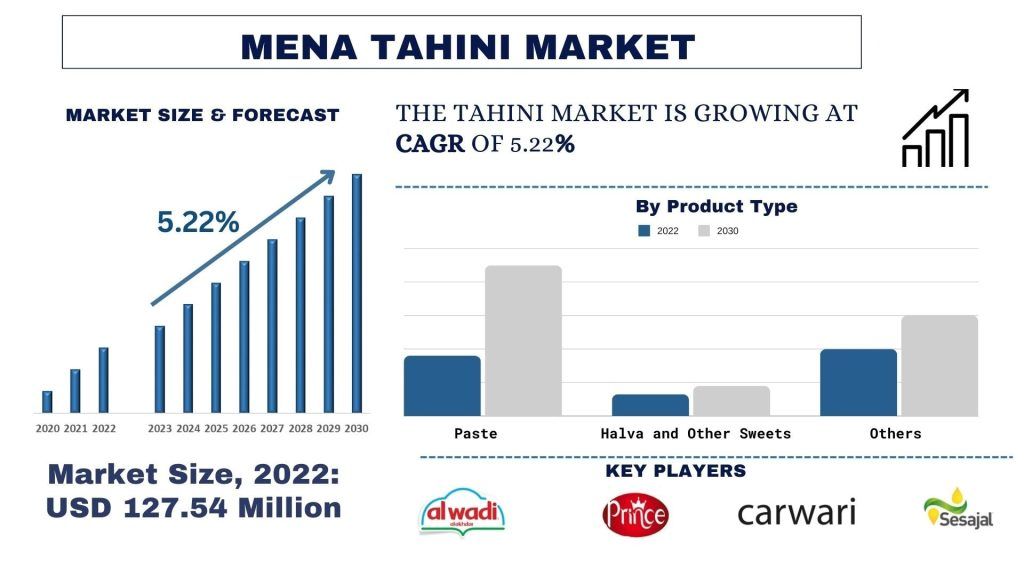
MENA Tahini Market Size and Forecast
The MENA Tahini Market was valued at USD 127.54 Million in 2022 and is expected to grow at a strong CAGR of around 5.22% during the forecast period (2023-2030).
MENA Tahini Market Analysis
The Middle East and North Africa (MENA) region has witnessed a notable surge in the adoption of tahini, reflecting a deep-rooted culinary heritage and a growing appreciation for traditional flavors. Tahini, a staple ingredient in Middle Eastern and Mediterranean cuisines, holds a revered place in the region’s gastronomic landscape, dating back centuries. However, in recent years, the tahini market in MENA has experienced a resurgence, driven by several factors including changing dietary habits, increased globalization, and the rising popularity of plant-based diets. As consumers become more health-conscious and seek out nutritious alternatives, tahini emerges as a versatile ingredient that is not only rich in flavor but also packed with essential nutrients such as protein, healthy fats, and minerals. Moreover, the growing awareness of tahini’s culinary versatility has led to its integration into a wide array of dishes beyond traditional favorites like hummus and baba ganoush, further expanding its appeal and market reach.
Some of the major players operating in Al Wadi Al Akhdar, Halwani Bros, Kevala, SESAJAL, Prince Tahina Ltd, Dipasa, El Rashidi El Mizan, Medivators Inc, Carwari International Pty Ltd, Mounir Bissat, Haitoglou Family Foods. Several M&As along with partnerships have been undertaken by these players to facilitate customers with hi-tech and innovative products/technologies.
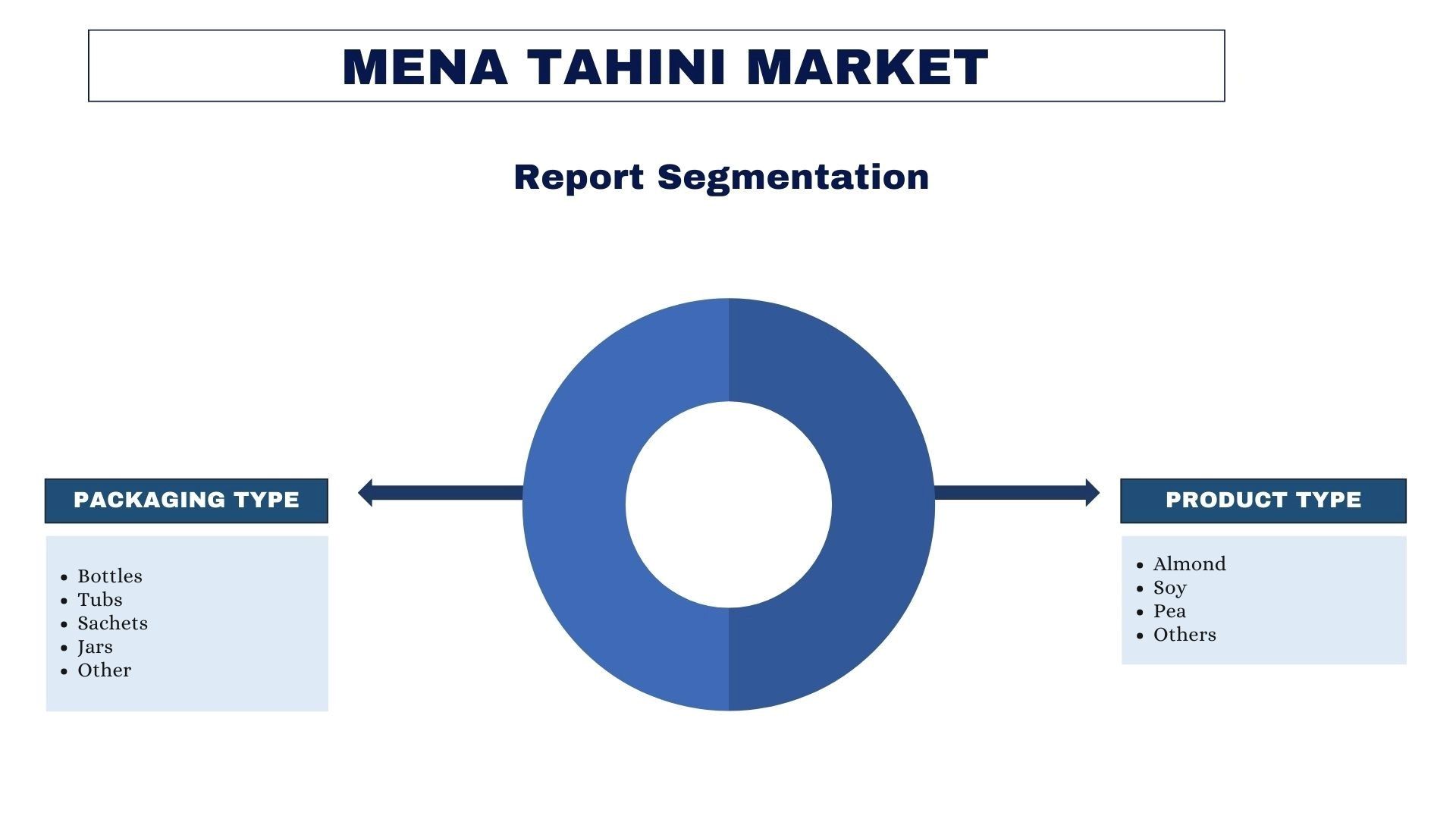
MENA Tahini Market Trends
“Amongst type, packaging type, the tahini market is segmented into bottles, tubs, sachets, jars, and others. The jars segment accounted for a significant market share in 2022.”
Based on packaging type, the tahini market is segmented into bottles, tubs, sachets, jars, and others. The jars segment accounted for a significant market share in 2022. The growing adoption of tahini in jars reflects a shift towards convenience and quality in the culinary world. Jars offer a practical storage solution, preserving tahini’s freshness and flavor with their resealable lids. Their transparency allows consumers to assess the product’s quality before purchase, enhancing trust in its authenticity. As consumers seek convenient yet high-quality ingredients for their cooking endeavors, tahini jars provide a versatile and nutritious option that aligns with modern culinary preferences.
“Saudi Arabia dominated the market.”
In Saudi Arabia, the adoption of tahini has been on the rise as the country embraces its rich culinary heritage and explores new flavors and ingredients. Tahini’s smooth consistency and earthy taste have found favor among Saudis who appreciate traditional Middle Eastern dishes like tahini sauce, halva, and tahini-based desserts. The Kingdom’s growing interest in health-conscious eating habits has also contributed to the popularity of tahini, known for its nutritional benefits and versatility in various recipes. For instance, according to a report by the Arab Brazilian Chamber of Commerce, the organic food market in the MENA region is experiencing annual growth rates ranging from 10% to 25%. This growth is largely attributed to the rising health consciousness among consumers. With a burgeoning food industry and a penchant for quality ingredients, Saudi Arabia presents a promising market for tahini producers looking to cater to a discerning consumer base. The growing demand for tahini in Saudi Arabia is not limited to traditional dishes; it extends to modern culinary creations as well. Chefs and food entrepreneurs are experimenting with tahini in innovative ways, incorporating it into contemporary dishes like smoothies, energy balls, and even ice cream. This trend is expected to continue as consumers seek out new and exciting ways to incorporate tahini into their diets.
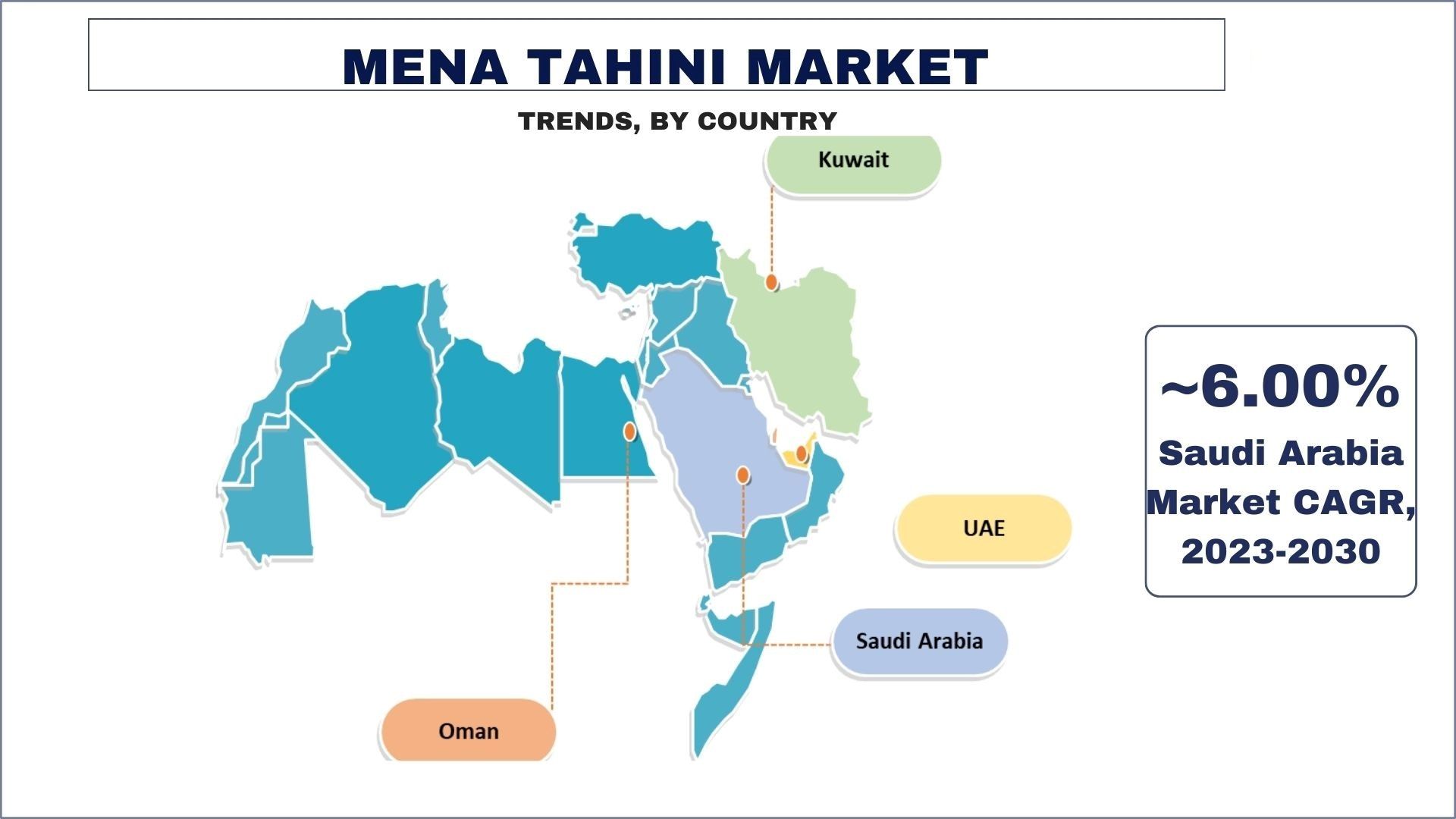
MENA Tahini Market Report Coverage
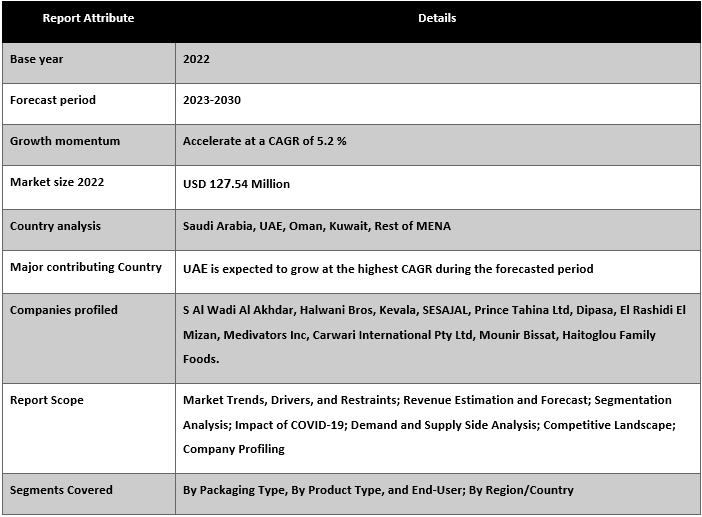
Reasons to buy this report:
- The study includes market sizing and forecasting analysis validated by authenticated key industry experts.
- The report presents a quick review of overall industry performance at one glance.
- The report covers an in-depth analysis of prominent industry peers with a primary focus on key business financials, product portfolios, expansion strategies, and recent developments.
- Detailed examination of drivers, restraints, key trends, and opportunities prevailing in the industry.
- The study comprehensively covers the market across different segments.
- Deep dive regional level analysis of the industry.
Customization Options:
The MENA Tahini market can further be customized as per the requirement or any other market segment. Besides this, UMI understands that you may have your own business needs, hence feel free to connect with us to get a report that completely suits your requirements.
Table of Content
Research Methodology for the MENA Tahini Market Analysis (2023-2030)
Analyzing the historical market, estimating the current market, and forecasting the future market of the MENA tahini market were the three major steps undertaken to create and analyze the adoption of MENA tahini in major countries. Exhaustive secondary research was conducted to collect the historical market numbers and estimate the current market size. Secondly, to validate these insights, numerous findings and assumptions were taken into consideration. Moreover, exhaustive primary interviews were also conducted, with industry experts across the value chain of the MENA tahini market. Post assumption and validation of market numbers through primary interviews, we employed a top-down/bottom-up approach to forecasting the complete market size. Thereafter, market breakdown and data triangulation methods were adopted to estimate and analyze the market size of segments and sub-segments of the industry pertains to. Detailed methodology is explained below:
Analysis of Historical Market Size
Step 1: In-Depth Study of Secondary Sources:
Detail secondary study was conducted to obtain the historical market size of the MENA tahini market through company internal sources such as annual reports & financial statements, performance presentations, press releases, etc., and external sources including journals, news & articles, government publications, competitor publications, sector reports, third-party database, and other credible publications.
Step 2: Market Segmentation:
After obtaining the historical market size of the MENA tahini market, we conducted a detailed secondary analysis to gather historical market insights and share for different segments & sub-segments for major regions. Major segments are included in the report as packaging type, and product type. Further country-level analyses were conducted to evaluate the overall adoption of testing models in that region.
Step 3: Factor Analysis:
After acquiring the historical market size of different segments and sub-segments, we conducted a detailed factor analysis to estimate the current market size of the MENA tahini market. Further, we conducted factor analysis using dependent and independent variables such as packaging type, and product type of the MENA tahini market. A thorough analysis was conducted for demand and supply-side scenarios considering top partnerships, mergers and acquisitions, business expansion, and product launches in the MENA tahini market sector across the globe.
Current Market Size Estimate & Forecast
Current Market Sizing: Based on actionable insights from the above 3 steps, we arrived at the current market size, key players in the MENA tahini market, and market shares of the segments. All the required percentage shares split, and market breakdowns were determined using the above-mentioned secondary approach and were verified through primary interviews.
Estimation & Forecasting: For market estimation and forecast, weights were assigned to different factors including drivers & trends, restraints, and opportunities available for the stakeholders. After analyzing these factors, relevant forecasting techniques i.e., the top-down/bottom-up approach were applied to arrive at the market forecast for 2030 for different segments and sub-segments across the major markets. The research methodology adopted to estimate the market size encompasses:
- The industry’s market size, in terms of revenue (USD) and the adoption rate of the MENA tahini market across the major markets domestically.
- All percentage shares, splits, and breakdowns of market segments and sub-segments
- Key players in the MENA tahini market in terms of products offered. Also, the growth strategies adopted by these players to compete in the fast-growing market.
Market Size and Share Validation
Primary Research: In-depth interviews were conducted with the Key Opinion Leaders (KOLs) including Top Level Executives (CXO/VPs, Sales Head, Marketing Head, Operational Head, Regional Head, Country Head, etc.) across major regions. Primary research findings were then summarized, and statistical analysis was performed to prove the stated hypothesis. Inputs from primary research were consolidated with secondary findings, hence turning information into actionable insights.
Key Stakeholders of MENA Tahini Market in the Middle East Region
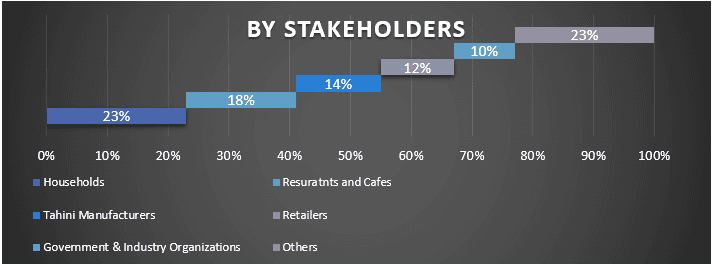
Market Engineering
The data triangulation technique was employed to complete the overall market estimation and to arrive at precise statistical numbers for each segment and sub-segment of the MENA tahini market. The data was split into several segments & and sub-segments post studying various parameters and trends in the areas of the packaging type, and product type of the MENA tahini market.
The main objective of the MENA tahini Market Study
The current & future market trends of the MENA tahini market were pinpointed in the study. Investors can gain strategic insights to base their discretion for investments on the qualitative and quantitative analysis performed in the study. Current and future market trends determined the overall attractiveness of the market at a regional and country level, providing a platform for the industrial participant to exploit the untapped market to benefit from a first-mover advantage. Other quantitative goals of the studies include:
- Analyze the current and forecast market size of the MENA tahini market in terms of value (USD). Also, analyze the current and forecast market size of different segments and sub-segments.
- Segments in the study include areas of the packaging type, and product type.
- Define and analysis of the regulatory framework for the MENA tahini
- Analyze the value chain involved with the presence of various intermediaries, along with analyzing customer and competitor behaviors of the industry.
- Analyze the current and forecast market size of the MENA tahini market for the major region.
- Major countries of regions studied in the report include Saudi Arabia, UAE, Egypt, Turkey, and Rest of MENA.
- Company profiles of the MENA tahini market and the growth strategies adopted by the market players to sustain in the fast-growing market.
- Deep dive regional level analysis of the industry
Frequently Asked Questions FAQs
Q1: What is the current market size and growth potential of the MENA tahini market?
Q2: What are the driving factors for the growth of the MENA tahini Market?
Q3: Which segment has the largest share of the MENA tahini market by packaging type?
Q4: Which country will dominate the MENA Tahini market?
Q5: Who are the key players operating in the MENA tahini market?
Related Reports
Customers who bought this item also bought

